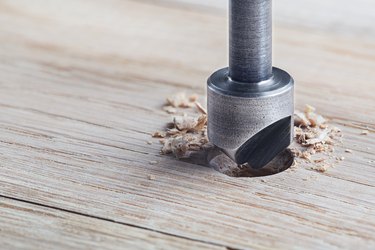
Drill bits are made for a wide range of needs and usages, and sometimes, it's hard to know which ones are meant for which purpose. That's important when you need to drill masonry bits, for example, because wood bits don't do well with brick and concrete. There will always be someone to tell you to "just read the package" (everybody has that one friend, right?), but that's not helpful once the bits have been opened or misplaced on your workbench or in your toolbox. It's more practical to learn the visual differences between them so you can identify them on sight.
Basic Design of Wood Bits
Video of the Day
The bits you'll use for wood are referred to generically as high-speed bits because they're meant for drilling through substances that aren't especially hard and therefore offer relatively little resistance to the drill bit. When you mentally picture a drill bit, this is the one you're envisioning. The tip is slightly blunt, and the spiral grooves running the length of the bit channel the sawdust away as you drill.
Video of the Day
These bits are almost always made from a metal called high-speed steel. It's a versatile, inexpensive steel that works well in undemanding-use cases. It typically contains chrome and vanadium, so in its native state, it looks rather like stainless steel, but you can't readily judge the kind of metal by looking at it because bits are often given a dark coating to inhibit rust.
Basic Design of Masonry Bits
Masonry bits resemble wood bits at a casual glance because they'll also have a deep spiral groove to help channel debris from the hole as you drill. The main visual difference is that masonry bits don't have the blunt, gently rounded tip you'll see on standard general-purpose bits. Instead, the tip is shaped rather like an arrowhead or is sometimes pentagonal like the home plate on a baseball diamond.
These tips help chew through the tougher, denser masonry, breaking it up into fine particles that can be channeled from the hole by the bit's grooves. Although you can use them with a conventional drill, they're most effective at drilling through masonry when used with a hammer drill. Hammer drills combine a spinning and a hammering motion, forcing your bit through the material with a lot less effort.
Masonry is tough, abrasive and sometimes caustic, so it's hard on drill bits. To counter this, masonry bits are often tipped with an extra-hard material called carbide or made from a steel alloyed with cobalt. You can even buy bits made entirely from carbide, which cost more but are correspondingly more durable.
Special-Purpose Bits
Your toolbox may also contain a number of special-purpose bits that don't fit the basic descriptions of standard-issue wood or masonry bits. Most of these give you a visual clue to their usage, so it's not as difficult as you'd think to tell them apart.
- Auger bits look like an oversized version of a conventional drill bit with what looks like a small wood screw at the very tip. They're for drilling through beams and other large, dense pieces of wood.
- Brad-point bits and spade bits have a chisellike edge on either side of the pointed tip, and they're used for making larger holes in wood.
- Forstner bits and self-feed bits are special-purpose bits for making smooth, even holes in wood. The ends of these bits are cylindrical but also have chisellike edges.
If you like to take on DIY projects and have accumulated a large variety of bits, your best bet may be to bookmark a site or two that gives a visual comparison of bits in list or chart form.
Wood vs. Masonry Hole Saws
Those bits are all for use with wood or woodlike materials, like the many composites that are used for deck building and similar applications. There is one kind of specialty bit that's available for use with both wood and masonry, and that's the hole saw. As the name suggests, they're made for drilling larger holes. It's a cylindrical, sawlike blade, which may or may not have something resembling a conventional bit in the middle to drill a pilot hole to guide the main portion of the bit.
Visual cues will quickly show you the difference between the two. If there's a pilot bit present in the center of the saw, it will resemble either a wood or masonry bit. That's your first visual cue.
A second is to look at the saw itself. If it has jagged teeth like a wood saw, it's designed for use with wood. Hole saws designed for use with masonry tend to have square-cut teeth and are typically made from thicker, more durable metal as well.